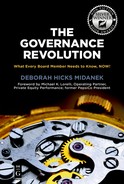Chapter 14
The Evolution of the New York Stock Exchange
As market composition has changed and many derivative instruments are actively traded, how has the NYSE adapted? “The Big Board” continued to be the world’s largest stock exchange by market capitalization of its listed companies at U.S.$21.3 trillion as of June 2017. The average daily trading value was approximately U.S.$169 billion in 2013.
The NYSE continues to trade in a continuous auction format, where traders can execute stock transactions on behalf of investors. The auction process moved toward automation in 1995 through the use of wireless handheld computers (HHC), which enabled traders to receive and execute orders electronically via wireless transmission ending a 203-year process of paper transactions and ushering in an era of automated trading. By 2007, the process was fully automated.
NYSE’s governing board voted to merge with rival Archipelago on December 6, 2005, and became a for-profit, public company. It began trading under the name NYSE Group on March 8, 2006. A little over one year later, on April 4, 2007, the NYSE Group completed its merger with Euronext, the European combined stock market, thus forming NYSE Euronext, the first transatlantic stock exchange.
Until the 2005 reorganization, the right to directly trade shares on the exchange was conferred upon owners of the 1366 “seats.” The term comes from the fact that up until the 1870s NYSE members sat in chairs to trade. These seats were a sought-after commodity as they conferred the ability to directly trade stock on the NYSE, and seat holders were commonly referred to as members of the NYSE.
Seat prices varied widely over the years, generally falling during recessions and rising during economic expansions. The most expensive inflation-adjusted seat was sold in 1929 for $625,000, which, today, would be over six million dollars. In recent times, seats have sold for as high as $4 million in the late 1990s and as low as $1 million in 2001. In 2005, seat prices shot up to $3.25 million as the exchange entered into the agreement to merge with Archipelago.
Seat owners received $500,000 in cash per seat and 77,000 shares of the newly formed corporation. The NYSE now sells one-year licenses to trade directly on the exchange. Licenses for floor trading are available for $40,000 and a license for bond trading is available for as little as $1,000 as of 2010. Neither is resalable but may be transferable during a change of ownership of a corporation holding a trading license.
In 2008 NYSE Euronext acquired the American Stock Exchange (subsequently renamed NYSE Amex Equities). Four years later NYSE Euronext was acquired by Intercontinental Exchange, an electronic trader of energy commodities, which sold Euronext but retained ownership of the NYSE. In 2017 the NYSE acquired the National Stock Exchange, based in New Jersey.
What is driving these transactions? As technology has changed the face of securities trading and derivatives markets have grown so significant, stock trading is less profitable, and volume is declining. By combining various exchanges and platforms, not only can cost be significantly reduced, but the franchise in what have become highly competitive markets expanded.
The result today is a global exchange operator diversified across markets including agricultural and energy commodities, credit derivatives, equities and equity derivatives, foreign exchange and interest rate products. Global stock and derivatives franchises now include global clearing house businesses and commodity futures with trading ranging from coffee to coal and crude oil to currencies. And remarkably, this trading is done in a public company format, as the NYSE itself copes with the pressures of quarterly earnings reports.
Consider the change in the roughly 400 years since the Amsterdam Stock Exchange was founded with one issuer’s stock listed, and in the two centuries since the Buttonwood Agreement. Also consider the potential impact on corporations who list their securities and the dealers who list them who find themselves having to recognize that they are no longer dominant players on the exchange.
During that period, and throughout the major systemic changes we have reviewed, the corporate form and its board of directors as an organizing structure has, however, endured. Its value is clear, yet the world in which it operates is not only radically changed but will only continue to change more rapidly. The corporation’s ability to continue to develop that value depends increasingly on informed and effective boards of directors. The governance revolution at hand requires us to move from our historically somewhat passive position to actively manning the ramparts to protect the enterprises for which we are responsible.
Read More
The Big Board: A History of the New York Stock Market, Sobel, Robert, Free Press, 1965 and Beard Books, 2000
The New York Stock Exchange: Its History, Its Contribution to National Prosperity, and Its Relation to American Finance at the Outset of the Twentieth Century, Vol. 1, Stedman, Edmund Clarence, Classic Reprint, 2010
Wall Street: A History, Geisst, Charles R., Updated Edition, Oxford University Press, 2012
